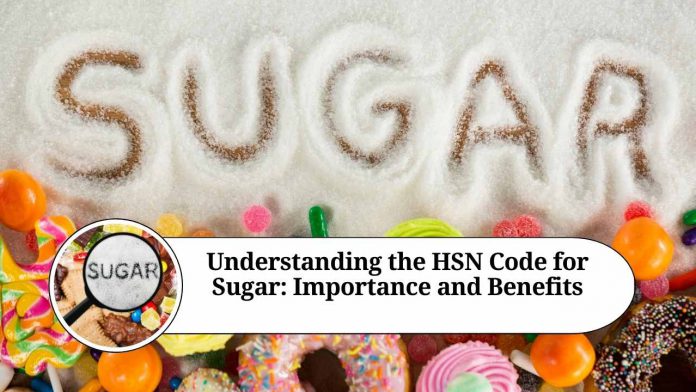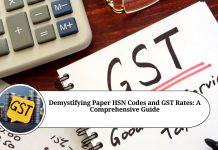Understanding the HSN Code for Sugar
The Harmonized System of Nomenclature (HSN) code is a standardized system of classification for goods traded internationally. The HSN code for sugar is an important tool for identifying the type and quantity of sugar being imported or exported. In this blog, we will explain what the HSN code for sugar is and how it works.
What is the HSN Code for Sugar?
The HSN code for sugar is 1701. This code is used to identify sugar and sugar confectionery products in international trade. The code is part of the larger HSN system, which is used by more than 200 countries to classify goods for customs and trade purposes. The HSN code for sugar is used to differentiate between different types of sugar, such as raw sugar, refined sugar, and brown sugar.
How Does the HSN Code for Sugar Work?
The HSN code for sugar is a six-digit code that is used to classify sugar products. The first two digits, 17, refer to the chapter on sugar and sugar confectionery products. The third and fourth digits, 01, refer to the heading on sugar. The last two digits, 00, refer to the subheading on sugar.
Different Types of Sugar and their HSN Codes
There are different types of sugar, and each has its own HSN code. Here are some examples:
- Raw sugar: HSN code 1701 11
- Refined sugar: HSN code 1701 99
- Brown sugar: HSN code 1701 14
- Sugar confectionery: HSN code 1704
It is essential to use the correct HSN code for the type of sugar being imported or exported. The HSN code determines the rate of duty that must be paid on the sugar and sugar confectionery products.
Importance of Using the Correct HSN Code for Sugar
Using the correct HSN code for sugar is crucial for importers and exporters. Incorrect classification can result in penalties, customs seizures, or even legal action. Moreover, using the correct HSN code ensures that the correct amount of customs duty is applied to the sugar product. For instance, raw sugar has a different duty rate compared to refined sugar, and using the incorrect code could result in an underpayment or overpayment of duties.
The HSN code for sugar also provides valuable data for trade statistics. The HSN code is used by customs officials to collect and analyze data on sugar and sugar confectionery products. This data is essential for policymakers, traders, and other stakeholders in the sugar industry to understand the trends in sugar trade, identify emerging markets, and develop strategies for growth.
Benefits of the HSN Code System
The HSN code system has several benefits for international trade, including:
- Standardization: The HSN code system provides a standardized system for classifying goods. This ensures that all countries use the same classification system, reducing confusion and errors.
- Simplification: The HSN code system simplifies the process of classifying goods for customs purposes. By using a single code, customs officials can quickly identify the type of goods being imported or exported.
- Accuracy: The HSN code system provides a high level of accuracy in classifying goods. This reduces the risk of misclassification, which can lead to errors in duty calculation or even legal action.
Conclusion
The HSN code for sugar is a critical tool for importers and exporters. By using the correct HSN code, businesses can ensure compliance with regulations, avoid penalties, and accurately calculate customs duties. The HSN code system provides a standardized and simplified approach to classifying goods, which improves accuracy and reduces the risk of errors in international trade. It is crucial for businesses in the sugar industry to understand the HSN code for sugar and use it correctly to ensure a smooth and efficient trade process.
Read more useful content:
Frequently Asked Questions (FAQs)
What is an HSN code?
An HSN code is a standardized system of classification for goods traded internationally. It is used to identify the type and quantity of goods being imported or exported.
Why is the HSN code important for sugar?
The HSN code for sugar is essential for identifying and differentiating between different types of sugar, such as raw sugar, refined sugar, and brown sugar. It is also used to determine the rate of duty that must be paid on sugar products.
What is the HSN code for sugar?
The HSN code for sugar is 1701. This code is used to classify sugar and sugar confectionery products in international trade.
What is the difference between raw sugar and refined sugar?
Raw sugar is sugar that has not been processed and contains impurities such as molasses. Refined sugar is processed to remove impurities, resulting in a purer product.
How does the HSN code for sugar work?
The HSN code for sugar is a six-digit code that is used to classify sugar products. The first two digits, 17, refer to the chapter on sugar and sugar confectionery products. The last four digits refer to the specific type of sugar product.
What happens if the wrong HSN code is used for sugar products?
Using the wrong HSN code can result in penalties, customs seizures, or even legal action. Moreover, using the incorrect code could result in an underpayment or overpayment of duties.
Do all countries use the same HSN codes for sugar?
Yes, more than 200 countries use the same HSN code system for classifying goods, including sugar and sugar confectionery products.
What is the benefit of using the HSN code system for sugar?
Using the HSN code system provides a standardized and simplified approach to classifying goods. This improves accuracy, reduces the risk of misclassification, and provides valuable data for trade statistics.
How can I find the correct HSN code for my sugar product?
You can consult with customs officials or refer to the Harmonized System Nomenclature (HSN) book, which provides a comprehensive list of HSN codes for different types of goods.
Is it possible to change the HSN code for sugar products?
It is possible to request a change in the HSN code for sugar products, but this must be done through the appropriate channels and with the approval of customs officials.




















